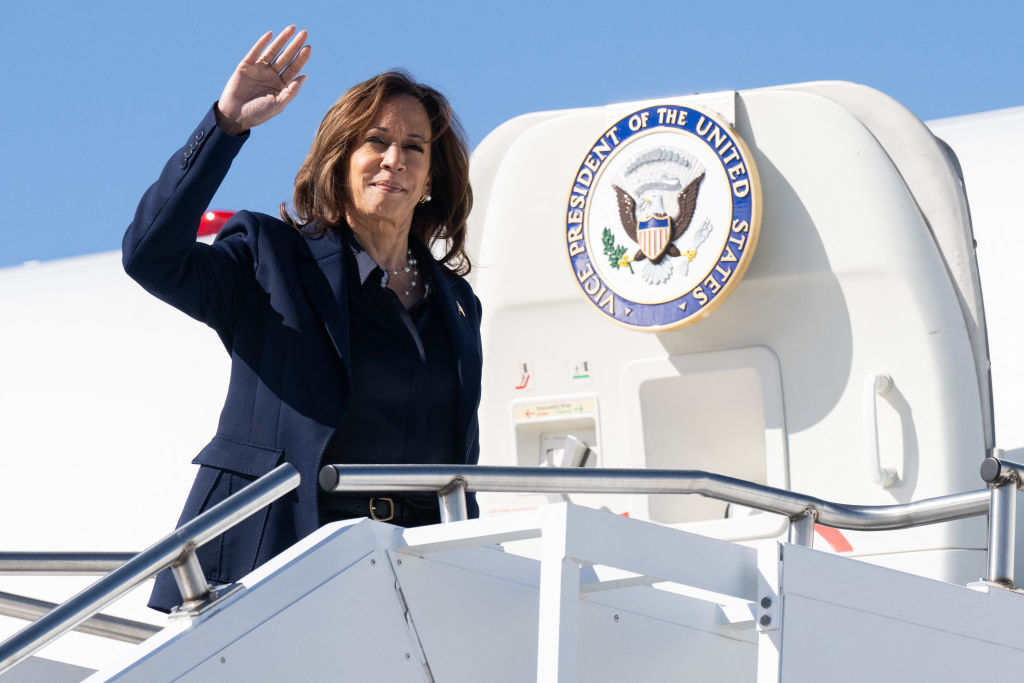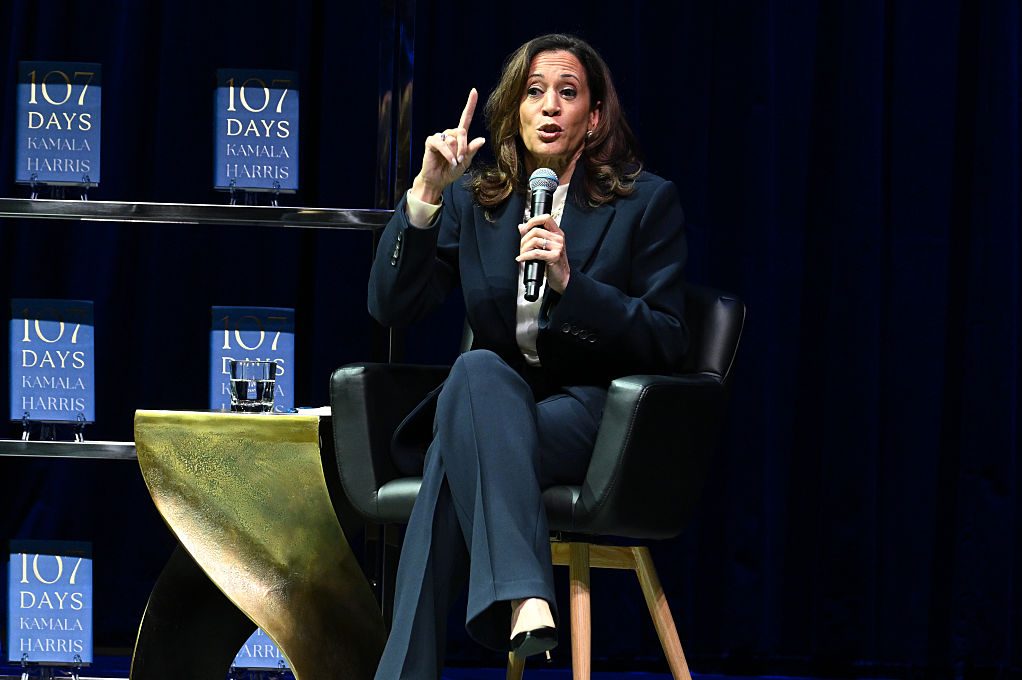Welcome to Thunderdome. Tonight I invite you all to tune into a live conversation at 8 p.m. Eastern with Kmele Foster of the Fifth Column on the shifting race, gender and class divides in 2024, part of the Substack Election Dialogues series — more details are here!
We’ve already surpassed 8 million early votes in this election, so that means we’re at the beginning of the final rounds with fewer than twenty days to go. For Kamala Harris, she’s still sprinting around with a media tour (well, really only 60 Minutes and last night’s Fox News interview count as media) that she really should have done months ago. And rather than closing things out by appealing to the handful of independents who will likely decide critical states like Pennsylvania, Georgia, Michigan and Wisconsin, she took to the airwaves last night with a shortened, filibustering, talking-point-filled approach designed to bolster her base but leave swing voters with nothing inspiring hope.
It’s an odd choice, and from my perspective, a missed opportunity:
This interview was an opportunity for Kamala Harris and a missed opportunity. She chose to sit down with Fox, which I think is a very good thing because it has the largest audience, including the largest audience of independent viewers that you are going to find on any cable station. I think she could have, in this moment, sounded a note of humility and grace about the failures of the last three and a half years, and frankly distanced herself from them in a way that I think is very possible, to say that, “I’m going to demand better when it comes to our border policy. I’m going to demand more from Homeland Security. I’m going to not let things like this lag under my administration.”
Instead, we got filibustering. We got an aggressive recitation of talking points that we have heard before. And I think that this was a huge missed opportunity for her. There are actual gettable voters for her, I believe, in key states like Pennsylvania. Nobody who tuned in, who falls into that category, can see a candidate here in Kamala Harris, who has learned anything from the last three and a half years. Instead, it sounded like she was just pitching to her comfortable base who are watching MSNBC and will be tuning in tomorrow to cope with Morning Joe.
For partisan viewers on the Democratic side, this was just Harris holding her own against an obviously biased Fox News questioner. Except it wasn’t — it was a straightforward series of non-gotcha questions that we’ve all been waiting to hear Kamala answer for months. And the best she had was credential-checking Nobel Prize experts and citing the wisdom of John Bolton and Mark Milley?
As Mary Katharine Ham pointed out in that segment, David Plouffe called the pre-planned interview, for which Harris showed up late and her staff attempted to cut the interview time by a third, an “ambush” — as if Bret Baier leaped out of the hedges, tie and hair impossibly perfect, to shove a microphone in her face and demand comment on Joe Biden’s melting brain. And even with the prep, we got more flailing talking points avoiding the issues and not even a commitment that the next four years won’t look like the last for years on border security.
Given all that, what was even the point of doing this interview? To check a box? To motivate the base? To pretend you’re bipartisan when you aren’t? I don’t honestly understand why the Harris campaign agreed to do this without a strategy to one, avoid any gaffes (the answers on transgender operations for illegals and Biden’s mental state were both fodder for ads) and two, make it possible for some right-leaning independents to see you as safe — a pro-energy candidate not beholden to far-left culture war craziness and a representation of security, stability and law and order. She didn’t achieve any of this.
I know some Democrats who are deeply disappointed in what they’re seeing from this campaign. That doesn’t mean Kamala is losing — she could still beat an unlikable, erratic candidate in Donald Trump. But it does mean the joy is gone — and the stink of desperation is in the air.
Who wins a less polarized electorate?
According to Matthew Yglesias, it’s Kamala Harris.
I was doing takes back in 2019 and 2020 about Donald Trump’s successful efforts to court Black and Hispanic voters, so I wasn’t surprised when he improved his numbers with non-white voters in the last election.
But the message was poorly received by progressives at the time, and there’s been a lot of denials ever since, to the point that things like this week’s New York Times poll showing further Trump gains with black and Hispanic voters come as a shock in certain quarters. I think that’s largely because this trend deals a blow to many progressives’ self-image in a way that’s out of proportion to its objective electoral significance. But self-image is important, and I want to make a few related points about these findings:
- Every pollster sees broadly the same trend toward racial realignment, but not every pollster sees it on the same scale as the NYT — this is part of an interesting larger conversation about methodology
- If the Times’s findings are correct, they are broadly good news for Kamala Harris, in the context of her small-but-steady lead in national polls
- It’s probably also good news for American society if voting patterns are less stratified by race
- Voters of color moving toward Trump is, in part, the result of the deliberate strategic choice by Democrats to dramatically increase the extent to which they run on abortion rights — a choice that, on the net, is smart
- Notwithstanding my relatively complacent attitude with regard to 1-4, the rightward shift of voters of color is genuinely difficult for many progressives to reconcile with their big picture view of American politics, and it underscores the need to try to be chill and assemble a big tent to win
The underlying dynamics benefiting Republicans down-ballot is a question, one that could depend on Trump’s unique appeal to black men. Harris’s attempt to appeal to them with a unique targeted agenda backfired a bit this week because it had to be expanded to everyone — turns out racially targeted policies can get unconstitutional real fast! For the GOP, her struggles to appeal to this demo have them hoping for an edge in Georgia.
The pews were filling up inside Mount Zion Baptist Church, where former president Bill Clinton was set to launch his rural campaign swing for Vice President Kamala Harris in this Democratic stronghold bordering a sea of rural red Georgia.
In the back, Joseph Parker said he was thrilled the Arkansan was coming. But it had been nearly a quarter-century since Clinton left office and, Parker said, “Things were really different then.”
This year, he said he’s voting for former president Donald Trump, the first time the seventy-two-year-old has cast a ballot for a Republican presidential candidate.
“Trump’s a man of his word. What he says he’s gonna do, he does,” Parker said, after initial reluctance to reveal his preference. “And everything is so high now — groceries high, clothes, everything, gas. And four years ago, it wasn’t that high. And so people see the difference in Kamala Harris and Trump, and they want some of what they had four years ago. And I do, too.”
In the final weeks of the campaign, Democrats are working to shore up the coalition that helped turn Georgia in their favor in the presidential election four years ago and in two Senate races in 2021. But in a state where President Joe Biden narrowly won in 2020, drawing 88 percent of the Black vote, months of public polling showing some Black men moving toward Trump is part of the reason the former president appears stronger in Georgia than this time four years ago.
More on this from Ralph Leonard at Unherd, who critiques Barack Obama’s patronizing remarks about why black men have to vote for her. And keep in mind, as much as the electorate looks less polarized by race, it may turn out to be the most polarized ever by gender. On that point, Richard V. Reeves has thoughts on why neither party is really doing a good job of forming an agenda for men.
Nagging concerns on Trump’s ground game
Lingering doubts about Turning Point have Republicans worried.
The Trump campaign has gambled that it can have outside groups including Turning Point Action pay people to knock on voters’ doors instead of doing much of this work in-house, as in prior campaigns. That group, the organizing arm of Turning Point USA, founded by the conservative activist Charlie Kirk, has GOP operatives particularly worried. Some Republicans in such places as Wisconsin and Arizona have said they aren’t seeing Turning Point Action make much progress, an allegation the group rejects.
A GOP operative in Michigan said the Trump campaign is knocking on one-tenth of the doors it did in 2016, though a Republican National Committee official said the campaign’s efforts have yielded five times as many Michiganders committed to voting for Trump this year as in 2016.
“Trump volunteers are just a different breed compared to your traditional breed of Republican volunteers,” said the operative, who works on GOP races. “Their idea of volunteering is doing a sign waving or a boat parade.”
The race for president appears virtually tied, and the election could be determined by a fraction of a percentage point in states including Wisconsin, Michigan and Pennsylvania. In 2016, Trump won Michigan by just over 10,000 votes out of more than 4.5 million votes cast. That is why, in addition to millions of dollars spent on advertising and digital outreach, many campaigns continue the old-school, shoe-leather tactic of knocking on doors.
In addition to Turning Point, much of the GOP ground game this year is being undertaken by Elon Musk’s America PAC, which has fired vendors on two separate occasions in the final months before the election. America PAC at one point paid its door knockers $30 for each door, according to people familiar with the matter. That is an exorbitant amount for such work, which more typically is closer to single digits for each door, people close to the industry said.
One more thing
One of the most dominant Democratic narratives since the pivot to Kamala — advanced again by the VP last night — is that the country isn’t exhausted with the Biden-Harris agenda, but by Donald Trump, who’s robbed the nation of its “joy.” As George Hawley notes at City Journal, lack of joy has a partisan divide — and it’s the Democrats who don’t have enough of it. “Republicans have consistently performed better than Democrats on subjective sense of well-being. This has been true in every GSS and regardless of which party dominates in Washington.” There are a lot of explanations for why this could be, and I doubt very much that even if Kamala Harris wins, it’s going to change anytime soon. Sounds like something Americans will have to figure out for themselves?


























Leave a Reply